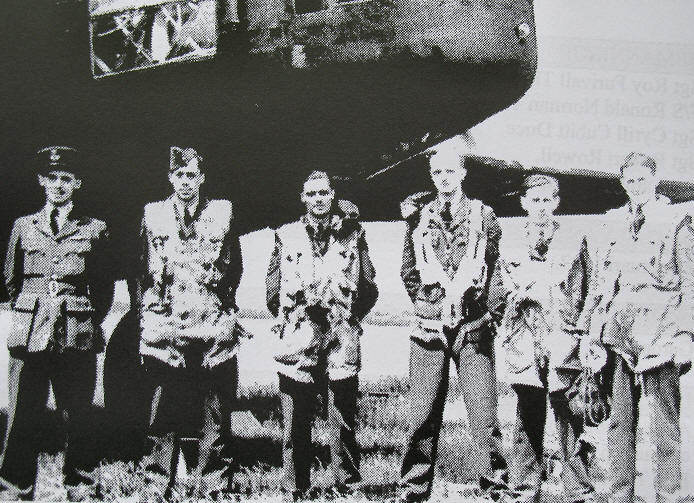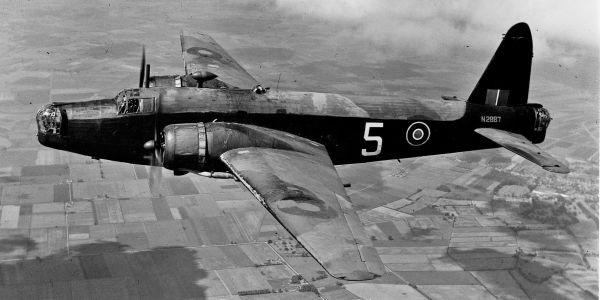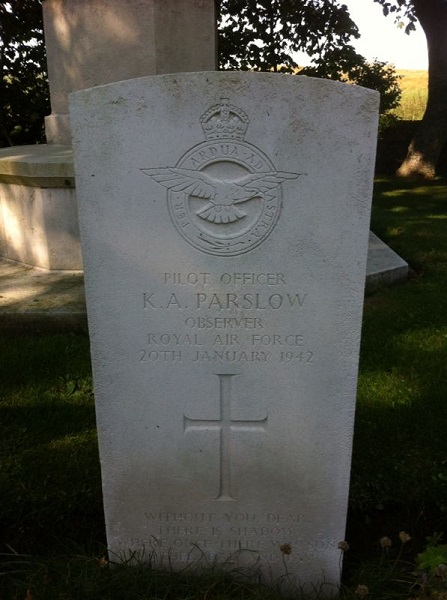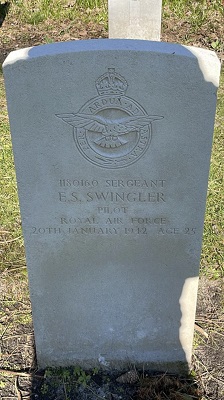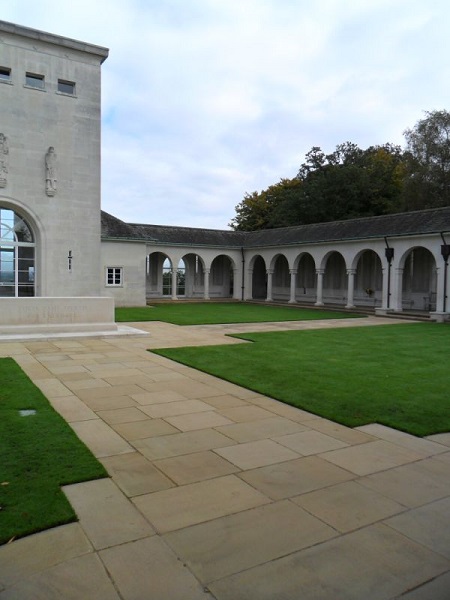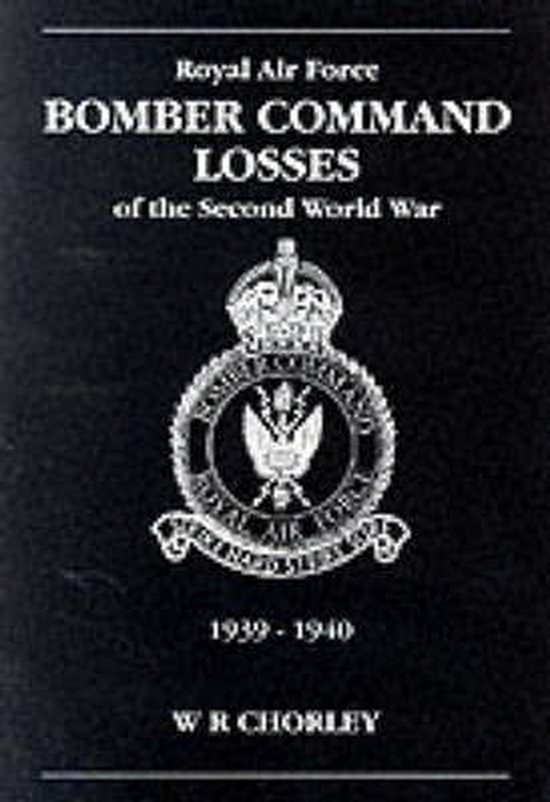Crash of Wellington Z1207 near Terschelling
Introduction
The Dutch Frisian Islands are the most northern part of The Netherlands. During the war more than 350 Commonwealth killed servicemen – mainly airmen and navy personnel – washed ashore on the islands beaches. Many of them could not be identified and were buried as unkowns. Most airmen were single members of crews which were lost over the North Sea. Like Pilot Officer Parslow and Sergeant Swingler, who are buried in the cemeteries on Ameland and Terschelling. They were two members of a six men Wellington crew that was lost on the night of 20/21 January 1942. The bodies of their companions were never found and these men are commemorated on the Runnymede Memorial.
Target Emden
RAF Bomber Command tried to inflict damage to the German war machine by means of strategic bombardments on industrial and military targets. Almost each night allied bombers took off to attack factories, warehouses, port installations and other targets. The seaport city of Emden in the northwest of Germany was chosen as the target on the night of 20/21 January 1942. Emden is located were the river Ems discharges into the Wadden Sea, part of the North Sea. Its strategical importance during the war came from the city being the nearest port for German vessels, making it a sensitive point in Germany’s industrial and transport system. The Nordseewerke U-boat yards also attracked the attention of RAF Bomber Command. The first U-boat was launched here in December 1940.
Emden had been attacked around thirty times in 1940-1941. Most of the attacks had taken place between March and July 1941 when Bomber Command concentrated its efforts on German ports as part of their strategy to attack targets which housed the sources of the threats to allied shipping in the North Atlantic. However, the attacks on Emden were mainly minor operations with only one or a few aircraft sent to the city. Only eight times the bomber force consisted of more than ten aircraft, with the attack on the night of 26/27 November 1941 being the heaviest and the only time the city was attacked by more than fifty aircraft. On the night of 20/21 January 1942 Bomber Command detailed twenty-five aircraft (twenty Wellingtons and five Hampdens) to bomb the docks. It was the fourth of five attacks on Emden in one week. No.142 Squadron was ordered to detail six aircraft for the operation, but one was cancelled owing to the heating system being unservicable. One of the machines selected for the operation was Wellington Z1207. It’s crew was as follows:
Pilot: Pilot Officer John Grant Scott (29 years old, Canadian)
2nd Pilot: Sergeant Edward Sextus Swingler (25 years old, British)
Observer: Pilot Officer Kenneth Archibald Parslow (22 years old, British)
Wireless Operator: Flight Sergeant Gwladgwyn John Sharp (24 years old, British)
Front Gunner: Flight Sergeant Albert William Kerrisk (23 years old, New Zealand)
Rear Gunner: Flight Sergeant Michael Thomas O’Brien (21 years old, British)
This was an experienced crew. Sharp was already serving with the squadron at the outbreak of war. He had been in France with the unit, although he did not fly any operations during the Battle of France (spring 1940). Parslow, O’Brien and Kerrisk had joined the squadron whilst it was replacing its Fairey Battle light bombers for the medium Vickers Wellington between November 1940 and April 1941. Scott was posted to 142 Squadron in June.
Scott, Parslow, Sharp, O’Brien and Kerrisk had been flying together since the beginning of July 1941 and had completed twenty-one operations. Originally this crew was captained by Flight Lieutenant George Milton Kelly but in early December Scott was promoted to captain the crew. He led the men on six operations. On the last three of them Swingler was flying as second pilot. Swingler had been posted in at the end of October 1941.
Fatal flight
The Hampdens of No.49 Squadron were the first (around 17:00hrs) to take off for Emden. Of the Wellington force, the aircraft of No.142 Squadron were the last to go up into the sky. The other four aircraft (see below for serial numbers and crews) took off between 18:35 and 18:40hrs. Wellington Z1207 left RAF Grimsby at 19:10hrs. The aircraft had to cross the coastline at Saltfleet and then fly over the North Sea to the German island of Juist. From there they had to head south to Emden. The return route was the same. The other four Wellingtons of No.142 Squadron all returned safely and reported a succesfull operation. There was cloud cover over the sea and visibility over the target was reported as perfect. Wellington Z1207 however failed to return and nothing was heard from the aircraft from take off.
Oberleutnant Robert-Ludwig Becker of Nachtjagdgeschwader 2 had taken of from Leeuwarden airfield in his Dornier Do 215 to intercept the allied bombers. Near the Dutch island of Terschelling Becker started his attack. He attacked Wellington Z8370 of No.12 Squadron. Two members of this crew were killed in the attack, but the pilot succeeded in making a succesfull emergency landing and the other four crew members survived. Seven minutes later Becker opened fire on Wellington Z1207. The bomber was seen to crash into the sea. Becker would also shoot down Wellington Z1110 of No.101 Squadron with the loss of all six crew members. Becker was mentioned in the Wehrmachtbericht of 21 January because of this achievement.
Missing believed killed
With no news on the fate of the crew, Wing Commander Stanley Bertram (Officer Commanding No.142 Squadron) informed the next of kin of the crew of Wellington Z1207. It was the beginning of a long period of uncertainty for the relatives of the six airmen.
On Sunday 12 July 1942 police officer Tjeerd Nijboer was patrolling the northern beaches of the island of Ameland. There he found the badly decomposed body of a male person. He could see from the badge on the right sleeve that the man was a British airman. In the collar of the uniform jacket he found the initials K.A. and the surname Parslow. Pilot Officer Parslow’s body was buried with militaity honours in the village cemetery on 14 July 1942. Six days later another airman washed ashore on the beach of the nearby island of Terschelling. This man was identified by his armband with his name and service number on it. Sergeant Swingler was buried in the island cemetery the next day.
In November 1942 the next of kin of the other four airmen were informed that in the view of the lapse of time and the absence of further news they were presumed to have been killed. The bodies of Scott, Sharp, O’Brien and Kerrisk were never found. Their names are engraved on the Runnymede Memorial in Englefield Green, Egham. They are commemorated on panels 75 (O’Brien), 76 (Sharp), 101 (Scott) and 117 (Kerrisk).
Extra information
If the reader of this article has further information on this bomber or its crew, then you are kindly requested to get in touch with the author by using the feedback form.
Definitielijst
- Bomber Command
- RAF unit which controlled strategic and sometimes tactical bombing (as in Normandy)
- Commonwealth
- Intergovernmental organisation of independent states in the former British Empire. A bomber crew could include an English pilot, a Welsh navigator, air gunners from Australia or New Zealand. There were also non-commonwealth Poles and Czechs in Bomber Command.
- RAF
- Royal Air Force. British air force
- Squadron
- A military unit in the Belgian navy usually six to eight small ships operating together under one command. The smallest military unit in the Dutch air force of about 350 men. In most countries is the designation of a military unit thesize of a company. It is either an independent unit, such as a battery, or part of a bigger Calvary unit. In the air force it is the designation of a unit of aircrafts.
- strategical
- Multiple meanings. Used by the Americans to indicate air force units that had bombers.
- strategy
- Art of warfare, the way in which war should be conducted in general.
- U-boat
- The German name for a submarine. German U-Boats (Submarines) played a very important role during the course of warfare until May 1943. Many cargo and passenger ships were torpedoed and sunk by these assassins of the sea.
Images
Wellingtons of No.142 Squadron involved in the operation
An overview of the other Wellingtons of No.142 Squadron which were detailed for the operation to Emden on the night of 20/21 January 1942.
Wellington Z1206 (QT-F)
Pilot: Squadron Leader Alexander Black Olney (27 years old, British)
2nd pilot: Sergeant Alan Harker (age unknown, British)
Observer: Pilot Officer Ross Baxter Ingalls (27 years old, Canadian)
Wireless operator: Pilot Officer J.S. Gronow (age unknown, British)
Front gunner: Sergeant Ralph Forster (21 years old, British)
Rear gunner: Sergeant E.B. Key (age unknown, Canadian)
Wellington Z1208 (QT-S)
Pilot: Pilot Officer Joseph Porter McCarthy (28 years old, Canadian)
2nd pilot: Sergeant Donald Coburn West (20 years old, Canadian)
Observer: Pilot Officer D.M. McCormick (age unknown, Canadian)
Wireless operator: Sergeant Martin Gasson Healy (29 years old, British)
Front gunner: Sergeant Kenneth Fishwick (age unknown, British)
Rear gunner: Sergeant Howard Matthew James (age unknown, British)
Wellington Z1316 (QT-H)
Pilot: Sergeant George Henry Mays (34 years old, British)
2nd pilot: Pilot Officer Donald Patrick McDonald (26 years old, Canadian)
Observer: Sergeant Victor Reginald Dufton (24 years old, British)
Wireless operator: Sergeant David Maxwell Laing (23 years old, British)
Front gunner: Sergeant Francis Geoffrey Huntley (21 years old, British)
Rear gunner: Sergeant Duncan Black McFarlane (27 years old, British)
Wellington Z1287 (QT-Q)
Pilot: Squadron Leader George Hugh Nichols Gibson (25 years old, British)
2nd pilot: Pilot Officer Stanley Brian Critchison (21 years old, British)
Observer: Pilot Officer Joseph Arthur Goring (29 years old, Canadian)
Wireless operator: Sergeant William Scott Findlay (29 years old, Canadian)
Front gunner: Sergeant William Lusk ‘Jock’ Harper (age unknown, British)
Rear gunner: Sergeant William Alfred Penney (26 years old, Canadian)
Definitielijst
- Squadron
- A military unit in the Belgian navy usually six to eight small ships operating together under one command. The smallest military unit in the Dutch air force of about 350 men. In most countries is the designation of a military unit thesize of a company. It is either an independent unit, such as a battery, or part of a bigger Calvary unit. In the air force it is the designation of a unit of aircrafts.
Information
- Article by:
- Pieter Schlebaum
- Published on:
- 14-01-2022
- Last edit on:
- 20-05-2024
- Feedback?
- Send it!
Related books
Sources
No.142 Squadron Operations Record Book
Wellington Z1207 (P4) Casualty File
